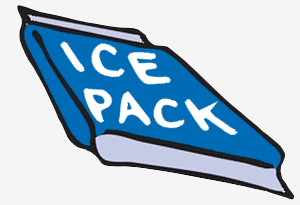Spontaneous chemical reactions are those that, after starting, continue without outside help; they move towards equilibrium with no need for an energy input from an external source.
Most spontaneous chemical reactions are exothermic - they release heat and warm up their surroundings: for example: burning wood, fireworks, and alkali metals added to water. When a radioactive atom splits up, it releases energy: this is a spontaneous, exothermic nuclear reaction.
Some spontaneous reactions, however, are endothermic, sucking heat out of their surroundings, cooling them down.

List of Spontaneous Reactions that Cool their Surroundings
Example 1: Barium Hydroxide Octahydrate and Dry Ammonium Chloride
Bringing crystals of barium hydroxide octahydrate and dry ammonium chloride together in a beaker is an experiment often used to demonstrate an endothermic reaction to classes. Water is spread below the reaction vessel and the reaction freezes the water, as you can see in this video:
The chemical reaction is:
Ba(OH)2·8H2O (s) + 2NH4Cl (s) → BaCl2·2H2O (s) + 2NH3 (aq) + 8H2O (l)
Example 2: Baking Soda and Vinegar
While most acid-base reactions are exothermic, the reaction of baking soda with vinegar is endothermic.
NaHCO3 (s) + CH3COOH (aq) → NaOOCCH3 (aq) + H2O (l) + CO2 (g)
The reaction of baking soda with other acids, like hydrochloric acid, is also endothermic.
NaHCO3 (s) + HCl (aq) → NaCl (aq) + H2O (l) + CO2 (g)
Discussion
Chemical reactions can only proceed spontaneously if the total free energy of the products is less than the reactants.
Hence reactions are spontaneous only when ΔG, the change in free energy, is negative.
The overall situation is summed up in the Gibbs expression for reaction free energy:
ΔG = ΔH - TΔS
ΔG is change in free energy
ΔH is the change in enthalpy (heat)
T is temperature in kelvin
ΔS is the change in entropy
Exothermic reactions have negative values of ΔH. The chemicals involved lose free energy by heating up their surroundings.
Endothermic reactions are those with positive values of ΔH. For these reactions, ΔG will be negative only if TΔS is bigger than ΔH. Hence these reactions are spontaneous only if the entropy increase is sufficient to overpower the unfavorable enthalpy change.
When solids become liquids or gases, the entropy (the number of ways the particles and energy in a system can be arranged) increases, hence endothermic reactions generally involve a change of state. At least one of the reactants will usually be solid, and at least one of the products will be a liquid or gas.
Returning to Example 2:
NaHCO3 (s) + HCl (aq) → NaCl (aq) + H2O (l) + CO2 (g)
ΔH = +28.5 kJ mol-1
T is 300 K
ΔS is +230 J mol-1 K-1
Hence ΔG = 28,500 - (300 × 230) J = −40.5 kJ mol-1.
Since ΔG is negative, this endothermic reaction is spontaneous.
Example 3: Cobalt(II) Chloride Hexahydrate and Thionyl Chloride
Adding thionyl chloride to cobalt(II) chloride hexahydrate results in an endothermic reaction. The equation is:
CoCl2·6H2O (s) + 6 SOCl2 (l) → CoCl2 (s) + 12 HCl (g) + 6 SO2 (g)
The release of a large number of moles of gas in this reaction results in a large entropy gain that drives it forward. Thionyl chloride is a well-known dehydrating reagent, but this reaction is not usually seen in classrooms because of its unfriendly reagents and products.
Endothermic Solvation
When some salts dissolve in water, there is a cooling effect. When everyday table salt, sodium chloride, dissolves in water, the mixture cools slightly. With potassium chloride, the cooling is much more noticeable. These are not a chemical reactions, because no new products are made. It is solvation. The salts can be recovered, unchanged chemically, by evaporating the water.
An increase in entropy as ions held within a crystal are released into solution allows the solvation of some salts to proceed endothermically.
Example: The Ice Pack

In general, dissolving an ammonium salt in water is endothermic, producing a cooling effect. This is the basis of commercial ice-packs used to produce instant cooling for treatment of sport injuries.
Ice packs are made with water and an ammonium salt in separate compartments. Breaking a seal brings them together resulting in cooling.
Ammonium nitrate and urea are the salts often used in these products. There is no chemical reaction. The crystal salt simply dissolves in water endothermically producing an instant reduction in temperature. For ammonium nitrate the solvation equation is:
NH4NO3 (s) + H2O (l) → NH4+(aq) + NO3- (aq)
